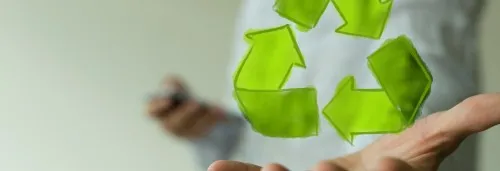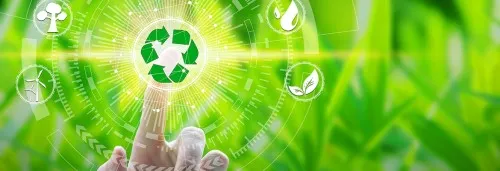
The comparison: compostable or conventional packaging?
- Compostable packaging promises a better eco-balance and more sustainable recycling - but is it true?
- Biodegradable plastics are coming on strong, in various industries and a wide range of applications.
- "Compostable" does not automatically mean "ecologically sound". For this, various factors (raw materials used, degradability of the packaging products) must be considered critically.
The proportion of biodegradable or even compostable packaging - measured against the total volume of packaging waste - is still low. But the market is there, because sustainable alternatives to conventional packaging are in demand both from consumers and from politicians.
COMPOSTABLE ALTERNATIVES FOR VARIOUS PACKAGING PURPOSES
That is why compostable packaging is now available for various product areas. Food, especially fruit and vegetables, for example, can be packaged in sustainably produced and biodegradable trays.
Shipping bags can be made from bioplastics and even coffee capsules are available as a compostable variant. Many municipalities also use biowaste bags that can be disposed of together with organic waste.
- Collection bags for organic waste
- Medical applications
- Foils (for example mulch foils or others)
- Filler material
- Catering products
- Agricultural products
- Dog waste collection bag
- Packaging, for example for tea bags
Source: European Network of Environmental Protection Agency Managers (EPANetwork) - Biodegradable Plastics. Approaches and empirical values from 16 member states of the EPA network.
BIO-BASED, BIODEGRADABLE - OR BOTH?
Compostable packaging materials are biodegradable in principle, but require special conditions to do so. These prevail primarily in industrial composting plants, while biodegradable plastics also decompose in the soil or in freshwater and seawater.
Subsequent recycling as compost also requires that the raw materials are selected appropriately during production. For this reason, compostable plastics lie at the intersection of biobased and biodegradable plastics.
The terminology surrounding biodegradable plastics is not particularly simple and requires a high degree of differentiation. Otherwise, biobased plastics, biodegradable plastics and bioplastics quickly become confused or are incorrectly used synonymously.
Agency for Renewable Resources e.V.
The fact that the terms are so close to each other masks the fundamental differences:
- For "bio-based" plastics, organic raw materials are obtained from renewable sources (such as corn, wheat, sugar beets, etc.). These, in turn, do not have to be "organic" in the sense of organic food, but can come from conventional cultivation.
Bio-based plastics do not have to be biodegradable. Bio-PET or bio-PVC, for example, are bio-based in production but cannot be biodegraded. - "Biodegradable" plastics, on the other hand, do not have to be produced with organic raw materials. In fact, there are also petrochemical plastics, i.e. plastics that are produced on the basis of crude oil or natural gas. These are nevertheless biodegradable, but just not biobased. They are also not suitable for composting.
In between, there is an intersection of plastics that exhibit both properties. They are of particular interest from a sustainability point of view, as they appear to have the best ecological properties from production to recycling. However, the fact that they are also compostable must first be confirmed in lengthy and elaborate test procedures.
EXAMPLES: FROM BIOBASED TO BIODEGRADABLE PLASTICS
Bio-based plastics are mainly obtained from three raw materials:
- Starch - from potatoes, wheat, corn or other plant parts
- Sugar - from sugar beet or sugar cane and cellulose
- Cellulose - from cotton or other plants
Bio-based plastics can be produced from these raw materials using various processes and substances.
Natural plasticizers and plasticizers, for example, turn starch into "thermoplastic starch" (TPS) in granular form. Thermoplastics can also be softened and deformed at higher temperatures without losing their chemical properties.
The addition of further polymer components results in a water-resistant end product. It is also conceivable to achieve this result by chemically modifying the starch. However, this is a considerable cost factor.
These include thermoplastic starch, starch blends, starch-filled materials, and polymers such as PLA and PHA.
Depending on the additives and processing method (destructuring, filling or fermenting), different products are created from natural and modified starch.
These include thermoplastic starch, starch blends, starch-filled materials, and polymers such as PLA and PHA.
The situation is different with biobased plastics based on lactic acid. In its polymerized form polylactic acid (PLA) has high strength, transparency and is just as thermoplastic as starch-based plastics, for example.
The major advantages are the low-cost production and the similarity to conventional plastics. This means that PLA can be produced and used in a wide variety of forms, for example as films, cans or cups. In addition, the properties can be varied.
At the same time, these are the disadvantages, because the production requires a high purity of the raw materials, which can only be achieved with great effort. Depending on their composition, PLA products are also hardly degradable.
Polyhydroxybutyric acid (PHB) is also versatile, and the biopolymer can be produced by various methods. Its properties are very similar to polypropylene, but it is biodegradable. However, industrial production is complex and requires large quantities of sugar.
Thermoplastics are particularly suitable for processing into packaging products. This is because they have a good barrier effect and aroma density and can be processed excellently by machine.
The range of possibilities extends from carrier bags and fruit and vegetable trays to yogurt pots,bottles, tubes and cans. Compostable packaging solutions are now available on the market. However, these are not yet mature in terms of their recyclability, so further research is needed.
COMPOSTABLE PACKAGING BETWEEN DESIRE AND REALITY
The decisive criterion for compostable packaging compared to conventional plastic packaging is the greater ecological benefit. However, this is precisely what needs to be verified in many respects.
Because this benefit must also always be considered in relation to the primary task of packaging, which is product protection - and not just for perishable food. Packaging must provide safety, guaranteeing an effective barrier against damage or other external influences. Only then can the integrity of goods and the shelf life of foodstuffs be ensured.
.png)
On the other hand, manufacturers are required both by law and by consumers to offer sensible solutions when it comes to the recyclability of packaging. As promising as compostable packaging materials may appear in this respect, the requirements are on the other hand equally high. The question in this context is whether uncompromised packaging is a realistic or feasible option at all - with regard to the following criteria:
- They combine product protection and degradability without compromise.
- At the same time, they can be both produced and sold at favorable prices.
- At the same time, they are 100 percent biodegradable.
ÖKOLOGISCH WERTVOLL? DER FAKTENCHECKTHE FACT CHECK
So it's not just about the eco-balance, although that is of course a central factor with compostable packaging. It is also about production conditions and costs on a primarily economic level.
Check 1: Economic efficiency
In principle, there are low-cost, bio-based plastics that are also biodegradable. However, this is by no means true for all of them. The production of PHB, for example, is not yet possible on an industrial scale.
Apart from that, the demand for plastics from renewable raw materials is increasing because they can be used in many industries. Under certain circumstances, this could lead to an increase in the price of raw materials. Similarly, costly manufacturing processes could have the following effects
Check 2: Raw materials
Compared to conventional plastics, biobased plastics actually initially have a better ecological balance sheet. This is due, among other things, to the fact that both production and disposal cause less CO2. In addition, non-regenerative raw materials such as crude oil are left out.
On the other hand, corn, potatoes, wheat or sugar cane are usually sourced from conventional cultivation. Ecologically, the use of fertilizers and pesticides is not an advantage, but a significant environmental burden.
Check 3: Degradability
From packaging to compost - that sounds like an excellent way to recycle packaging. Despite the strict legal requirements for compostability, this has so far hardly offered the desired benefits.
This is because mainly CO2 and water are produced during decomposition. The proportion of usable compost is comparatively small, and its use as high-quality compost is also doubtful.
This disadvantage is also due to the industrial composting processes, which provide relatively short periods for degradation. The Federal Environment Agency and other institutes therefore conclude that, as things stand, incineration is the most sensible solution. In this way, at least, energy recovery can be achieved.
.png)
CONCEPTS FOR THE FUTURE
However, the market for biodegradable or even compostable packaging materials is in a state of continuous development. Improvements in terms of raw material extraction (from biowaste, for example) and recycling/recyclability are part of this.
In addition, we should not forget the enormous importance of recycling when dealing with packaging. "Conventional" packaging can be (re)recycled much better in the materials cycle. Of course, there is still room for optimization here as well.
Nevertheless, recyclable materials remain the most important focus for Labelprint24 when it comes to sustainable packaging and production processes. Compostable packaging products are nevertheless a future trend that may not yet realize its full potential. Further developments will show to what extent compostability of packaging can establish itself as a real alternative to recycling.
These articles may also interest you:

Compostability: What are the laws and standards?
Packaging waste is a significant problem, especially in the quantities generated today. In Germany alone, the total amount in 2017 was 18.7 million tons, according to the Federal Environment Agency.

Compostable, Recyclable and Co
The topics of nature conservation, environmental protection and sustainability are becoming increasingly important in all areas of life. Sustainable and recyclable materials are therefore an important factor in our industry.

Natural cardboard for folding boxes that inspire
Natural cardboard has gained considerable popularity as a packaging material in recent years. Packaging often consists of the well-known plain brown cardboard.




